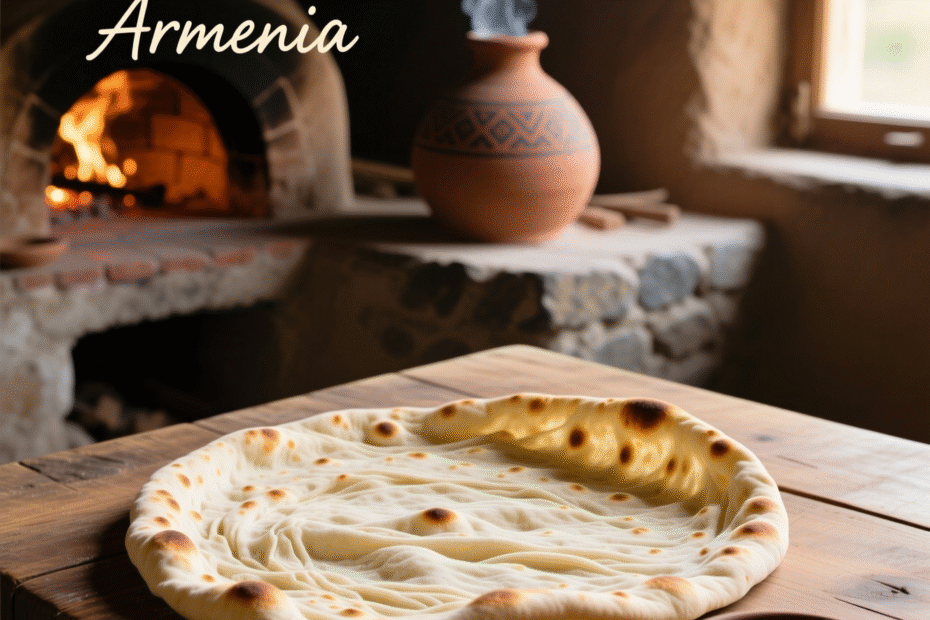Imagine biting into a piece of bread so thin it almost melts on your tongue, yet so full of flavor and history that it transports you straight to the sun-drenched hills of the Armenian highlands. That’s Armenian lavash—a humble flatbread with a legacy as rich as the soil where it’s baked.
More than just a staple on dinner tables, lavash is a symbol of heritage, community, and resilience. In fact, UNESCO recognized it as an Intangible Cultural Heritage of Humanity in 2014, not just for how it’s made, but for the cultural rituals that surround it.
In this article, we’ll explore the fascinating world of Armenian lavash—from its ancient origins and traditional preparation methods to its role in modern kitchens and global cuisine. You’ll discover why this simple flatbread has captivated generations, how to make it at home, and why it’s more than just food—it’s a living tradition.
Whether you’re a curious foodie, a home baker, or someone interested in cultural preservation, there’s something here for everyone. So, let’s roll up our sleeves and dive into the warm, aromatic story of lavash.
The Ancient Roots of Lavash: A Bread Woven into History
Lavash isn’t just old—it’s ancient. Archaeological evidence suggests that flatbreads similar to lavash have been baked in the Armenian Highlands for over 5,000 years. Carvings found in ancient temples and medieval manuscripts often depict scenes of bread-making, with women slapping dough onto the hot walls of tonirs—the traditional clay ovens still used today.
What makes lavash truly special is how deeply it’s embedded in Armenian identity. It’s not merely sustenance; it’s a cultural artifact. Historically, lavash was baked communally, with entire villages gathering to prepare large batches that would last for weeks. The bread was often dried and stored, then rehydrated with water or broth when needed—a clever preservation method long before refrigeration existed.
Even the act of baking lavash carried symbolic weight. Newlyweds were wrapped in lavash as a blessing for prosperity and fertility. Bread was never wasted; crumbs were carefully collected, and stale lavash was repurposed into soups or croutons. This reverence for bread reflects a broader cultural ethos: respect for food, family, and the land.
Today, while modern ovens have replaced tonirs in many homes, the spirit of lavash remains unchanged. It’s a reminder that some traditions are worth preserving—not just for their taste, but for the stories they carry.
How Lavash Is Made: Simplicity Meets Skill
At its core, lavash is astonishingly simple: just flour, water, salt, and sometimes a touch of yeast. But don’t let its minimal ingredients fool you—making authentic lavash is an art that demands precision, timing, and a bit of muscle.
The process begins with kneading a soft, elastic dough. Once rested, it’s divided into small balls and rolled out paper-thin—often less than 1 millimeter thick. This is where the real skill comes in. The dough must be stretched evenly without tearing, a technique passed down through generations, usually from mother to daughter.
Then comes the dramatic part: the dough is slapped onto the scorching inner walls of a tonir, a cylindrical clay oven buried in the ground and heated with wood or charcoal. Within 30 seconds, the lavash puffs up, develops delicate golden spots, and is peeled off with long metal hooks. The result? A soft, pliable flatbread with a faint smokiness and a whisper of char.
For those without a tonir (which is most of us!), a cast-iron skillet or pizza stone can mimic the effect at home. The key is high heat and speed. Even better, lavash freezes beautifully—so you can bake a big batch and enjoy it for weeks.
Pro tip: If your lavash turns out brittle, it’s likely overcooked or rolled too thin in spots. Aim for even thickness and remove it from heat the moment it starts to bubble.
Lavash in Daily Life: From Rituals to Modern Meals
In Armenian households, lavash is as essential as rice is in Asia or tortillas in Mexico. But its role goes far beyond the dinner plate. It’s a multi-functional culinary tool—used as a wrap, a plate, a scoop, and even a napkin.
Traditionally, meals are served on large sheets of lavash, which absorb juices and flavors, then get eaten along with the food. During holidays like Easter or Christmas, lavash is placed under festive dishes as a symbol of abundance. It’s also central to “lavash weaving”—a practice where dried lavash is braided or folded into decorative shapes, often gifted during celebrations.
In modern kitchens, lavash has found new life. Chefs around the world use it as a low-carb alternative to tortillas or pita, stuffing it with grilled vegetables, hummus, or spiced lamb. It crisps up beautifully for homemade chips or croutons, and its neutral flavor pairs well with both sweet and savory fillings.
For home cooks, lavash offers endless versatility:
- Wrap it around falafel or kebabs for a quick lunch.
- Layer it in lasagna-style bakes instead of pasta.
- Brush it with olive oil and za’atar for a fragrant flatbread snack.
Its simplicity is its strength—lavash adapts without losing its soul.
Lavash Around the World: A Global Journey with Local Roots
While lavash is distinctly Armenian, similar flatbreads appear across the Middle East and Central Asia—Persian sangak, Turkish yufka, Georgian shoti—each with its own twist. But what sets Armenian lavash apart is its texture and cultural context. Unlike crispier regional variants, Armenian lavash is prized for its softness and flexibility when fresh.
Interestingly, lavash has traveled far beyond the Caucasus. Armenian diaspora communities—from Los Angeles to Beirut to Paris—have kept the tradition alive, often baking lavash in adapted home ovens or community centers. In recent years, it’s gained popularity in health-conscious and gluten-free circles, especially when made with alternative flours like spelt or einkorn.
Even supermarkets now carry packaged lavash, though purists argue it lacks the soul of tonir-baked bread. Still, commercial availability has introduced millions to this ancient staple. Food bloggers showcase lavash pizza, lavash tacos, and even lavash dessert wraps filled with Nutella and bananas—proof that tradition and innovation can coexist.
Yet, Armenians remain protective of lavash’s origins. When neighboring countries claimed it as their own in the early 2000s, it sparked a diplomatic “bread war”—a lighthearted but serious reminder of how food can be tied to national identity. UNESCO’s recognition in 2014 settled the matter, affirming lavash as a shared but distinctly Armenian heritage.
Preserving Lavash: Why This Tradition Matters Today
In a world of mass-produced bread and instant meals, lavash stands as a quiet act of resistance—a reminder to slow down, connect with our food, and honor the hands that prepare it. Preserving lavash isn’t just about saving a recipe; it’s about safeguarding a way of life.
UNESCO’s designation highlighted not only the bread itself but the social practices surrounding it: communal baking, intergenerational teaching, and ritual use. These are the threads that hold communities together, especially in times of displacement or cultural erosion.
For younger Armenians, learning to make lavash is a way to reconnect with their roots. Workshops in Yerevan and diaspora cities now teach the craft to teens and adults alike. Some schools even include lavash-making in cultural curricula, ensuring the knowledge isn’t lost.
And you don’t have to be Armenian to participate. By baking lavash at home—using traditional methods or modern hacks—you’re joining a global movement that values slow food, sustainability, and cultural appreciation. Every roll of dough is a small tribute to centuries of resilience.
As climate change and industrial farming threaten traditional agriculture, supporting heritage grains (like Armenian wheat varieties) used in authentic lavash also becomes an eco-conscious choice. It’s food with purpose.
Conclusion: More Than Bread—A Living Legacy
Armenian lavash is far more than a flatbread. It’s a bridge between past and present, a symbol of unity, and a testament to the power of simple ingredients treated with care. From its ancient origins in tonir ovens to its modern reinventions in kitchens worldwide, lavash continues to nourish both body and soul.
We’ve explored its deep historical roots, the skill behind its preparation, its everyday versatility, its global journey, and why preserving it matters in today’s fast-paced world. Each of these layers reveals a truth: food is never just food. It carries memory, identity, and love.
So why not give lavash a try? Whether you bake it from scratch using a skillet or pick up a package at your local market, take a moment to appreciate the story behind it. Share it with friends, wrap your favorite fillings inside, or simply savor it with a drizzle of honey and a cup of tea.
And if you’ve ever tasted lavash or have Armenian heritage, we’d love to hear your story. Have you baked lavash with family? What memories does it bring up for you? Leave a comment below, share this article with a fellow food lover, or try making your own batch this weekend. After all, traditions live on not in museums—but in our kitchens, our conversations, and our shared tables.

Thayná Alves is an influential digital content creator who has carved out a significant space in the realms of technology, finance, and entrepreneurship. Through her blog, Newbacker.com , she stands out as an authentic and accessible voice for individuals seeking practical information about investments, innovation, and emerging trends in the financial market.
